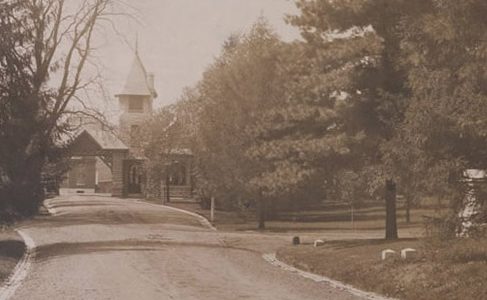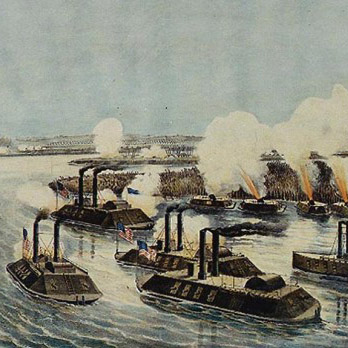
On August 30, 1904, thirty-two athletes from four nations lined up for a forty kilometer race at the 1904 Olympics in St. Louis. It was the marathon race at the III Olympiad, and what happened over the next twenty-five miles or so is one of the best stories in the history of the sport. I’ve stood up for the St. Louis Olympics in a previous post on this blog, but there’s no defending the marathon. It was a debacle. Before I get to what happened in the race, you have to imagine St. Louis in August. It’s hot. It’s really hot. The humidity is awful, there’s rarely any wind, and being outside while just standing still is no fun. The idea of running a marathon in that kind of heat is insane. True to form, St. Louis kicked in a scorcher on marathon day in 1904. When the race started around 2:30pm, temperatures were above 90, the humidity was brutal, and the runners faced a course with seven large hills. It was going to be a long day.
The race started with five laps of the Olympic Stadium and then headed west into St. Louis County. A team of horses preceding the runners kicked up dirt on county roads that were not paved. Automobiles following the runners made it worse. Runners quickly found it difficult to breath through the clouds of dust. To make matters worse, the only water station on the route was a small well at mile twelve.

Conditions were so bad that of the thirty-two runners, only fourteen completed the race. As runners dropped out, the crowd back at the stadium became weary waiting for the runners to return. After three long hours, an American named Frederick Lorz appeared in the distance. In actuality, Lorz had dropped out of the race back at mile nine. After quitting, he hitched a ride for several miles. The car broke down, prompting Lorz to hop out and jog back to the stadium. When he got there, the crowd assumed he was the leader. As cheers erupted from the crowd, Lorz realized nobody in the stadium knew he had quit the race. He decided to see how far he could carry on the ruse. He ran around the stadium and crossed the finish line. Although he quickly admitted his joke, race officials were not amused. He was disqualified.
The most colorful competitor was Felix Carvajal, a poor postman from Cuba. His country wouldn’t pay for his trip to St. Louis, so he raised the money to get to St. Louis on his own. He got as far as New Orleans before losing all of his money in a craps game. He resorted to hopping boxcars and hitchhiking to get to St. Louis. Upon arrival, he endeared himself to the American weightlifters who gave him a room and food to eat. For the race, he lined up at the start wearing his street clothes. A discus thrower found some scissors and cut his pants off at the knee to make shorts.

According to some sources (like Wikipedia), Carvajal was the subject of another good story. Having traveled far while not having much to eat, Carvajal became hungry during the race. He stopped at an orchard and ate a few apples which turned out to be rotten. This gave him a stomach ache which caused him to lie down and take a nap. Despite his lengthy slumber, Carvajal still finished in fourth place.
However, according to historian George R. Matthews, the story is false. In his book America’s First Olympics: The St. Louis Games of 1904, Matthews states that there is absolutely no record of Carvajal stopping to eat rotten apples and becoming ill. Matthews recounts that Carvajal had a jovial demeanor, he joked with officials and competitors, and he grabbed some peaches from a reporter, but that’s about it. Matthews pins the source of the tale to Bill Henry and his book, The Approved History of the Olympics, published in 1948. Henry wrote his book with the “approval” of Pierre de Coubertin, a man who did not see or support the St. Louis games in any way (more on that topic here). Along with the apple story, Matthews states that several St. Louis Olympic facts put forth by Henry are false.

Chaos reigned throughout the race. Leaders dropped out one by one. One runner dropped out after having a vomiting attack. Another collapsed with a stomach hemorrhage. Two officials suffered serious injuries when they crashed their car into a ditch. Two men named Len Tau and Jan Mashiani became the first black Africans to compete in an Olympics. They were in St. Louis as part of the South African Boer War exhibit at the World’s Fair. Len Tau ran so well that he finished ninth. He would have finished even higher if a wild dog didn’t chase him off the course for over a mile.

In the end, the final winner was American Thomas Hicks. He barely made it himself. With seven miles to go, Hicks was lagging. To revive him, his manger gave him 1/60th of a grain of strychnine and an egg white. It helped, but Hicks became demoralized when Fred Lorz passed him on his way back to the stadium. Even when he learned Lorz had been disqualified, Hicks begged his managers to let him stop. They refused, giving him another dose of strychnine, two more egg whites, and a chaser of brandy. Poisoned and exhausted, Hicks somehow wobbled back, stumbling around the stadium while being supported by his managers. He collapsed through the finish line with a time of 3:28:53. It was the slowest Olympic marathon ever. Hicks almost died as a result. Doctors quickly worked to revive him, declaring that he had “a very low vitality”. Fortunately, Hicks recovered, collected his gold medal, and promptly retired from running marathons.


My drink for this post really doesn’t have anything to do with the Olympics or the marathon. Instead, I tied it to a special day of my own. For the past several years, I have been biking to work once or twice a week. It’s a short ride, only 8.5 miles, to get from my house in south city to my office in downtown St. Louis. I’ve found biking to work is a good way to see the city and a great way to start the day. Back in February of this year, I set a goal of biking to work ten days in a row. I hit the ten-day mark and decided to see if I could hit fifteen. I hit that, and decided to go for one month. As I hit each goal, I realized I was loving it. I started taking new routes, I was getting faster on the bike, and I was saving a ton of money. I’ve even lost a few pounds (I’d probably lose a few more if I didn’t enjoy my cocktail drinking so much).
Last month, I hit my latest goal of riding the bike to work 100 days in a row. To celebrate, I used the GPS to track my special route through Tower Grove Park that morning. Here’s what it looked like after I exported it to Google Earth.

On the way home that day, I stopped at Van Gohz, a bar at the corner of Shenandoah and Compton. I bike by this place each day, but I had never been inside. I needed a Manhattan on day 100, so I stopped to check it out. It didn’t result in a memorable cocktail, but I shouldn’t be overly critical the nice folks at Van Gohz. It’s obvious that it’s just not a place where great care is taken to mix a drink. I mean, the first thing you see when you walk inside is a Golden Tee machine.
I asked for Makers in the Manhattan, but I let him go to see how the drink would be made. Realizing it was a special day, I stopped him when he picked up the rocks glass. I politely asked for it to be served straight up and in a cocktail glass. However, I didn’t catch him in time before the shake. And what a shake it was! He actually had to stop and rest during his human blender impression. Frothy Manhattan comin’ right up!

For the record, “drawing” with a GPS is not my idea. I’ve seen it somewhere on the Internet before, but it was done on foot. I thought it was a really creative idea that could be used to get a point across. A few days later, I used Tower Grove Park again to bike-a-sketch what a perfect Manhattan cocktail should look like (cherry optional).




Awesome post Cameron, as usual. I always enjoy them, but this one made me laugh out loud, having lived in the Lou for several years and endured many unbearable Augusts-I can imagine how miserable it would be to run a race (of any length) there. It was a great story. Love your biking drawings too!
Hi! My fiance and I met you at the Campbell house this past weekend, we are the couple in Lafayette Square. I am so enjoying this blog that compiles two of my favorite subjects, St.L history and drinking! These are amazing stories, Thanks for sharing!
Hey! Thanks for reading, and thank for coming for a tour! Sorry I had to rush you guys out of there. I hope to do a post soon about the cyclone we talked about. Also, check out Campbell House’s blog. It’s really good. The Assistant Director of the museum maintains it.
http://campbellhousemuseum.wordpress.com/